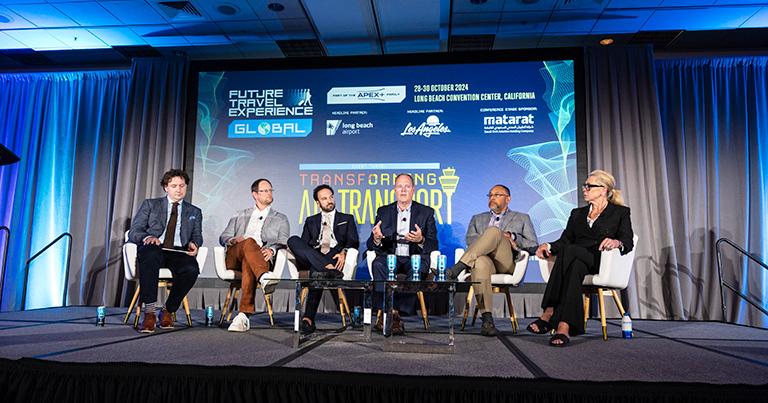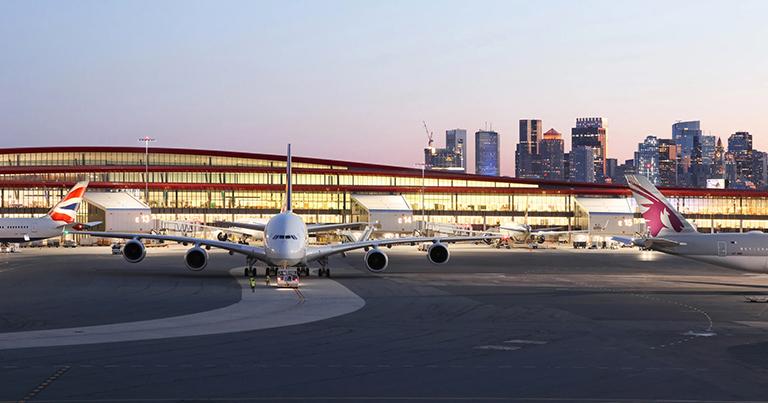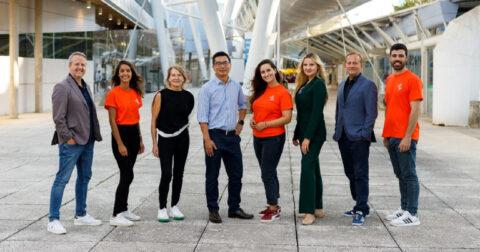AECOM was a Platinum Sponsor of FTE Global – the “CES of Aviation” – which took place in Long Beach on 28-30 October 2024. An undoubted highlight of the event was the FTE Airport Design & Development Think Tank, Captained by Yvonne Bilshausen, SVP | Global Head of Aviation, Architecture + Engineering, AECOM. In this thought-leadership interview, Bilshausen shares her perspective on the exciting challenges and bold visions that are redefining the future of airport design and development.

The Think Tank discussed key factors to consider when developing future airport facilities, with Team Members also including Bryant L. Francis, Director of Airports, Cleveland Airport System; Guðmundur Daði Rúnarsson, CCO and Airport Development Officer, Keflavik Airport; Kaveh Dabiran, Managing Director, Corporate Real Estate Planning & Development, United Airlines; Mike Hardaker, Chief Asset & Development Officer, Manchester Airports Group; and Mike Christensen, Chief Development Officer, Los Angeles World Airports.
“We need to evaluate the impact of technology, the preferences of current and future generations, sustainability initiatives, and evolving mobility trends,” Bilshausen explains. “Our goal is to establish minimum standards that every airport should uphold to guarantee a high-quality experience for both passengers and employees.”
AECOM specialises in innovative built solutions and services for the aviation industry. It focuses on designing and delivering efficient, sustainable airport facilities and infrastructure that enhance passenger experience, operational efficiency, and return on investments. “Our approach to terminal planning, design, and delivery is anchored by three dynamic pillars: cutting-edge digital integration, innovative sustainability practices, and a focus on human-centric design that puts the traveller at the heart of every decision,” says Bilshausen. “We leverage advanced technologies to enhance operational efficiency, safety, security, and passenger experience. This includes smart systems for check-in, security, and baggage handling. Our designs utilise eco-friendly materials and energy-efficient systems, emphasising sustainable practices like rainwater harvesting, solar energy, and green building certifications to minimise environmental impact and set a standard for future airport operations.”

Designing spaces that enhance passenger experience through intuitive layouts
AECOM’s goal is to design spaces that enhance the passenger experience through intuitive layouts for easy navigation, comfortable waiting areas, and diverse amenities, while incorporating stakeholder input and user research to meet travellers’ expectations and preferences.
Bilshausen emphasises a series of key areas that highlight AECOM’s commitment to prioritising digital integration, sustainability, and human-cantered design in airport planning and design for the terminals of the future:
- Elevating passenger experience:“Designing airports to prioritise seamless navigation, comfort, and efficiency involves implementing clear signage, intuitive layouts, and a variety of amenities to address diverse passenger needs.”
- Prioritising efficiency and functionality: “Airports are dynamic transportation hubs that demand peak performance, prompting AECOM’s architects and engineers to design terminals that facilitate effortless passenger flow, efficient security processes, and seamless baggage handling, transforming commercial air travel into a truly enjoyable experience.”
- Commitment to sustainability:“Sustainable design practices are becoming essential for the future of architecture, inspiring architects to creatively integrate energy-efficient systems, eco-friendly materials, and innovative green building strategies that not only minimise environmental impact but also elevate the entire experience of the built environment.”
- Emphasising flexibility and scalability: “Designs must be visionary and flexible, allowing for seamless adaptation to future growth and cutting-edge technologies, ensuring they can effortlessly accommodate increasing passenger volumes and meet the ever-evolving demands of modern travel.”
- Embracing technological integration: “Modern terminals must be at the forefront of innovation, seamlessly weaving advanced technologies into every aspect of the travel experience, from streamlined check-in and enhanced security processes to dynamic passenger information systems that keep travellers informed and engaged.”
- Innovative design solutions:“AECOM’s designers strive to craft iconic designs that deliver a strong return on investment, and not only captivate the eye but also elevate terminal functionality, blending stunning aesthetics with practical features to redefine the commercial air travel experience.”
- Interdisciplinary collaboration:“Dynamic collaboration between our architects, engineers, planners, and other experts is crucial to ensure that our designs not only meet but exceed operational, safety, and technical standards, resulting in innovative and effective solutions.”
- Passenger-centric features: “By prioritising diverse passenger needs – such as inviting dwell areas, gourmet dining options, and vibrant retail spaces – we elevate the travel experience and significantly enhance traveller satisfaction, turning airports into enjoyable destinations in their own right.”
- Cultural relevance: “Infusing local cultural elements into the terminal design creates a rich, authentic identity that resonates with passengers, transforming their journey into a meaningful experience that reflects the unique spirit of the community.”

AECOM is a trendsetter – with innovative design and digital technology, it transforms clients’ challenges into exceptional solutions. Its ultimate showcase of innovative solutions for complex challenges is the remarkable Boston Logan Terminal E Expansion. “As AECOM’s Global Head of Aviation Architecture and Engineering, I am beyond thrilled to share my admiration for the inspirational planning, architecture, engineering, and construction of BOS Terminal E,” says Bilshausen. “This incredible project is a true testament to innovation, creativity, and sustainability in aviation infrastructure. From the moment you see the exterior of Terminal E, the red roof design captivates with its stunning blend of modern aesthetics, bold use of colour, and functional elegance. Led by Terry Rookard, Jonathan Rushmore and a team of highly talented AECOM architects integrated cutting-edge technology with timeless design principles, creating a structure that is both visually striking and highly practical. Walking through Terminal E, you will be inspired by the seamless harmony between form and function. It’s a space that not only meets but exceeds expectations, providing an environment that is calm, comfortable, and efficient.”
Reflecting on FTE Global, Bilshausen adds that it presents a truly unique opportunity to connect with visionary thinkers and share insights that can drive the aviation industry forward. “Nothing is quite like FTE Global – events like this are vital for fostering collaboration, sparking innovative ideas, and cultivating meaningful connections with fellow innovators who share our passion and vision. Engaging in these conversations not only inspires us, but also strengthens our collective commitment to shaping the future of aviation.”







